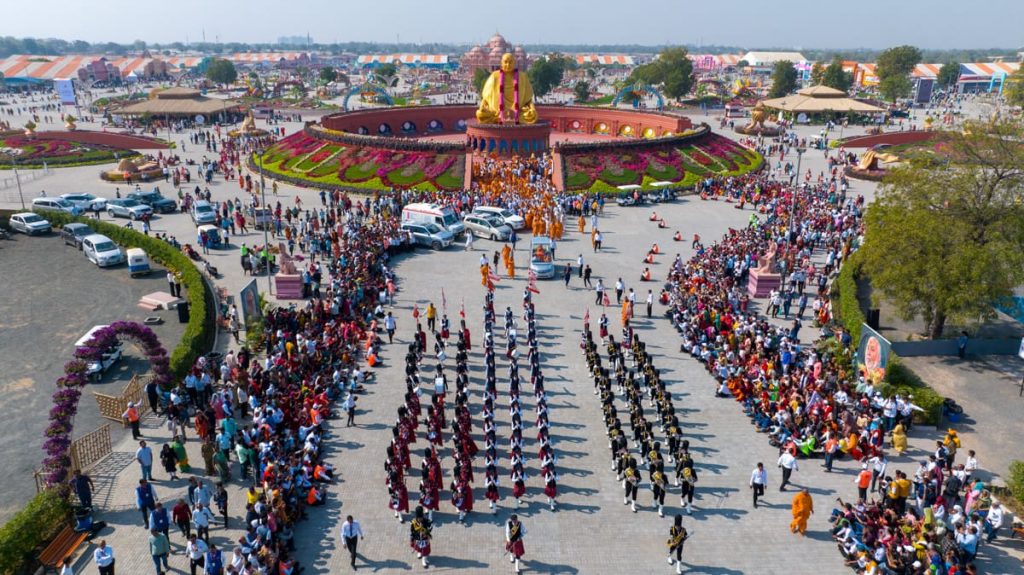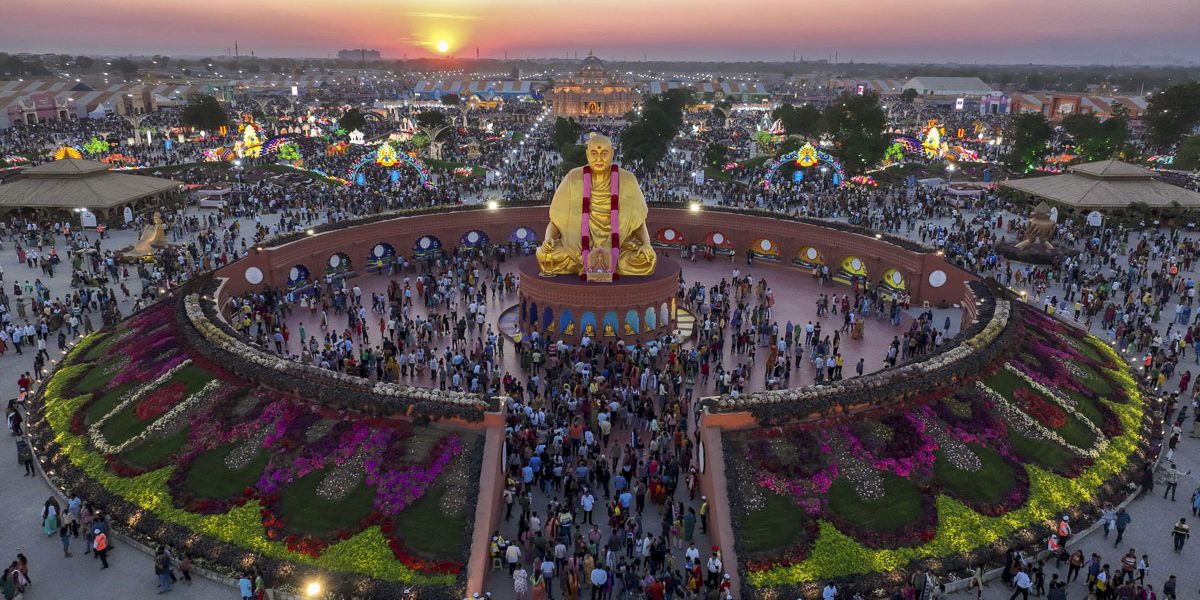Overview
- Landscaping of a total of 7 acres in the town
- 1200 Dumper Planting Soil Filling
- 125 Plants of different species
- 250 Plants of different colors
- 10,35,108 Total plants
- 12,000 Trailing petunias raised in net houses and used in town
- 5,000 Pots of chrysanthemums planted in the nursery and used in the town
- 10,000 pots of different ornamental plants in pots
- Drip irrigation system was established all over the town- a total of 12.9 km pipe used, a total of 122 km drip used
- 100 plots of size 55x 95 feet used for nursery
- Net house of 82,000 sq ft
- Seva of 400 volunteers for 8 months (approx. 8,19,200 man-hours)
- Seva of 200 women volunteers for 4 months (approx. 1,92,000 man-hours)

SPECIAL PLANTS
■ Ground Petunia
▪Petunia is a plant of the Amazon forests of South America. Petunia is famous for its multi-colored flowers. Petunias come in red, white, pink, purple, light blue, yellow, and almost all colors. If given the right growing environment, petunia plants produce flower buds in 6 to 8 weeks. Petunias take 15 to 20 days to grow in the greenhouse before they can be planted outdoors.
▪ First of all, ground petunia seeds are raised in a nursery in Pune and transplanted into trays as required. After the growth of the plant is sufficient and as the need arises on the ground, we bring it to the nursery in the town. They are kept in the nursery for 2 days for acclimatization in Ahmedabad. Then as per the condition of the plant, it is sprayed with fungicide and insecticide as required. Finally, it is separated according to the landscape design of the town and then they are carried over to the particular place. By then, plantation ground has been prepared by leveling, manure mixing, and fine grading of the soil. It is then planted in the ground. Leaf pinching is done after 10 days of planting to ensure good growth of buds.
■ Trailing Petunia
▪ This plant spreads 3 to 4 feet. They make a beautiful, colorful ground cover. It can be used in window boxes or hanging baskets. This attractive plant has been used in our town. Trailing petunias are fully grown in 3 to 4 months.
▪ Petunia is watered in the nursery by the drip irrigation system. PC drippers are used in irrigation systems. 2 water tanks of 35,000 liters have been used for the irrigation of this plant. Fertilizer is supplied along with water. Flowers growing in the petunias are pinched (picked) by women volunteers and offered in worship to Mahant Swami Maharaj.
▪ Firstly, the trailing petunia seeds are raised in a nursery in Pune and transplanted into trays as required. After the plants grow enough, they are brought to the nursery in the town. As the plant grows, it is transplanted from the tray to the container. For full growth of the plant, it is given pesticide, fertilizer, and water as per requirement. Then, leaf pinching is done after 10 days of planting for better growth. Fungicides and insecticides are sprayed as required according to the condition of the plant. The flowers of the plants are picked regularly to ensure that the plants are in full bloom during the Shatabdi time. In the final stage, petunia baskets are taken to the town and hung over in that particular place in town.
■ Chrysanthemum
▪ Chrysanthemum is a plant native to East Asia and Northeastern Europe. Most of the species originate from East Asia and its center of diversity is in China. Chrysanthemum plants are fully grown in 5 to 6 months.
▪ First chrysanthemum seeds are raised in a nursery at Pune and transplanted into trays as per requirement. Pinching of the leaves is done for the growth of the plant and washing is done from time to time in monsoon. After the plants grow enough, they are brought to the nursery in the town. As the plant grows, it is transplanted from the tray to the pot. Pesticides, fertilizers, and water are given to the plant as required for its full growth. Moreover, 2000 bulbs are used for this plant to grow with special daylight.
■ Victoria lily (Victoria amazonica)
▪ Victoria lily plants have very large leaves, up to 3 m (10 ft) in diameter, which float above the surface of the water on submerged stems. The stems are 7–8 m (23–26 ft) in length. It is the second-largest water lily in the world. It is native to the shallow waters of the Amazon River basin. These leaves are really strong and can easily hold the weight of a small human (up to about 65 pounds- 30 kg). Lilies look beautiful and delicate because they live on the surface of the water, but the undersides of their leaves have sharp thorns (spikes) that protect them from herbivorous fish. A Victoria lily is fully grown in 4 months or so.
▪ Firstly, Victoria Lily seeds are grown in the muddy water at Pune and brought to the town as per requirement. Their seeds are transplanted in a pond of muddy water in town. The water level in the town pond is maintained at 1 foot. Victoria lily pond water temperature is maintained at 26-32* Celsius.
■ Pansy
▪ Pansies (Viola × Vitrokiana) are a type of large-flowered hybrid plant grown as a garden flower. Pansies have heart-shaped, overlapping petals that come in a variety of bright, beautiful colors and patterns. Other flowers also look beautiful when planted with other cool-season flowers. The history of the pansy is forever linked to its ancestor, the viola. Viola is a large genus with over 500 species. The viola was familiar to people living in Greece in the fourth century BC. The original center of the viola was Europe. The hardy but delicate viola was cultivated by the Greeks for herbal medicinal use. Most of the new pansies bred in the last 50 years have been bred in Germany, the United States, and Japan.


Major attractions of the town
■ Main Entrance Gate
A 5 ft plant bed around the main entrance gate is used as a plinth protection and decorative foreground. Various types of antiques like carts, pataras, matlas, gantalas, kothis, tree trunks are used in the entrance circle of all the gates.
■ Pramukh Swami Maharaj Murti
Petunias and pansies have been used in the slopes around the PSM murti. A total of 24 flower modules have been used to represent each hour of the day. Each wing has 6 modules representing Pramukh Swami Maharaj working day and night (24×7). The Tilak and Chandalo depict the religious symbol of the BAPS Swaminarayan Sanstha. A total of 40,000 petunias and pansies have been used in PSM Murti slopes. Chrysanthemum plants have been used in the topmost ring of the slope, to create the scene of a garland around the neck of Pramukh Swami Maharaj.
■ Kalash
A freehand landscape design has been created in the Kalash using different colored petunias and pansies. A total of 20,000 petunias and pansies are used in the Kalash slopes.
■ Glow Garden
The Glow Garden features free-hand landscape design mounds varying from 3 feet to 8 feet high. The inside of the mounds are artificial glow flowers and the outside is real petunia flowers. A total of 1,40,000 plants are used in Glow Garden.
■ Glow Garden Spots
The entire landscape is designed around a theme. Also, according to the spot, there are plants such as Touch-Me-Not (Lajamani) around the Jagadish Chandra Bose spot whose leaves sprout instantly when touched proving that “the plant has life”. Camel Spot- Camel is a desert animal. Different plants growing in the desert have been planted around it.
■ Akshardham
Trailing petunias are hung using artistic metal structures of peacocks, flowers, vases, traditional chhatri, artistic trees, etc.
■ Balnagari
Different types of plants have been used according to different needs and themes.
■ Yagnashala & Bhajanananda
Different types of religious plants like Ked, Ashopalava, Tulsi, Damro, Rudraksha, Kailashpati, and roses have been used in the Yagnashala and Bhajan Kutir.

